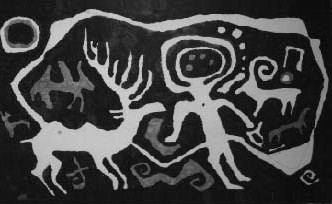Mystery Keepers
7 Essence: Earth Scent
th
Indigenous Nativo Materia Medica
7th Essence is the wisdom of Earth scent used for health. Earth scent refers to the chemistry of Earth and its particular use as botanicals for maintaining physical and spiritual health and for healing.
The impact that indigenous medicine has made on contemporary medicine is nothing less than enormous. To this day, 60% of the commercial pharmaceuticals are based on historical uses by indigenous Nativo. What is not understood is that the commercially produced derivatives do not exact the effacacy of the botanicals in their natural state. In other words, the synergestic effect has been lost in the pharmaceuticals, because it is impossible, either scientifically or economically, to commercially produce a pharmaceutical that is complete compared with the complex natural interactions within the natural botanical. Commercial processing strips away the synergistic activity that is achieved with natural interaction of a symphony of associated compounds.
The indigenous medicine of the Americas was far advanced over the European counterpart. While the traditional ways of nature medicine were largely lost by early European cultures, the nature medicine of indigenous Nativos was handed down through generations. The Nativo contribution of medicine was based on the proactive maintaining of health and natural healing remedies. There are over 200 natural medicines in the Official Pharmacopoeia of the United States and the National Formulary of which 170 are from North America. The Nativos had effective remedies for healing nervous disorders, astringents used for surgery, antiseptics cathartics, febrifuges for fevers and vermifuges for parasites.
Not only did the Nativo medicine keepers have numerous natural drugs at their disposal, they also had bulbed syringes for cleaning wounds and administering medicine to wounds, enema bulbs, and dental inlays of gold and stones. They executed amputations, skull surgeries, and Caesarian sections. In South America, the shock of the electric eel was used to revive paralysis. They also used potatoes dipped in clay to prevent indigestion--souring of the stomach. It wasn't until the 1950's that kaolin (a clay) was first used in common antacids. In obstetrics, Nativo practices was centuries ahead of Europeans. Nativo medicine was used extensively in rural areas up to World War I by millions of pioneer folk and many are still found in the Farmers Almanac. During the 19th century, trained physicians were rare in the American frontier, and even so were not always wanted because of a quickness to use the scalpel and often with poor success. This resulted in numerous lay persons, spread across the frontier, treating health and illness relying on the Nativo medicine. The Nativo medicine was held in high esteem by pioneers. Eventually, profiteers selling worthless "snake oil" or "Indian elixers" degradated the use of Nativo medicine ways in lieu of the more "advanced" physician's medicine. Slowly, the Nativo medicine ways began to vanish from both cultures, however, there is a core of practitioners that have revived the Nativo medicine.
An early encounter (1535-1536) of Europeans with the medicine way was the ice locked ships of Jacques Cartier in the St. Lawrence seaway. By the end of March 25 of 110 men had died of scurvy. A local chief, Domagaia, hearing of the fate of the sailors, had the woman gather branches (spruce) and make a drink that rapidly brought health back to the men. Up until 1776 when a British naval officer read of the incident in the ships log and put 2 and 2 together, Europeans believed scurvy was caused by 'bad air'. Nativos of the Yukon prevented scurvy by eating the adrenal glands of big game animals. Modern science has recently discovered that adrenal glands are the richest source of vitamin C of any animal or plant.
The scientific arrogance of many researchers prevented them from exploring the medicine way. But others were much more open to the nature medicine. One such researcher, Dr. Banting, discovered insulin and attributed the "Indian healers" with the "pharmaceutical spadework" that lead to the treatment of diabetes. The Nativo of British Columbia treated diabetes with an liquid extracted from a prickly plant called Devil's club. Later studies proved its effectiveness studying its use in rabbits.
Re-affirmation of Nativo medicines by physician researchers occurred again and again. A variety of foxglove for its use as a cardiac stimulant that ultimately lead to digitalis. Cinchona bark by South American Nativos for to treat malarial fevers. After quinine (ingredient in cinchona) was synthesized the cinchona bark trade was abandoned until the Viet Nam war when it was again used because the malaria developed resistance to the synthesized form. Common aspirin use is also attributed to the medicine way that used the willow tree. Evidence also exists for the use of antibiotics long before penicillin was 'discovered' by Dr. Fleming in 1929.
